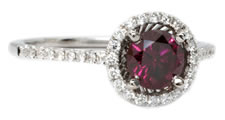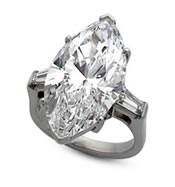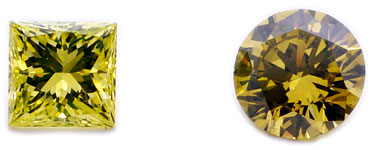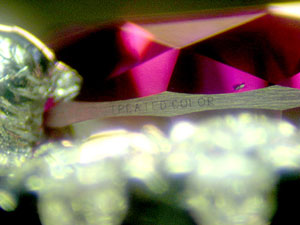Disclosure: HPHT
 Over the past year or two, gemological labs have received a large influx of HPHT-treated diamonds. Jewelers are also seeing more of such color-treated diamonds.
Over the past year or two, gemological labs have received a large influx of HPHT-treated diamonds. Jewelers are also seeing more of such color-treated diamonds.
The twin issues here are: Valuation & Disclosure.
What is HPHT?
High pressure and high temperature in the earth make the diamond. In a lab, high temperature and high pressure (HPHT) can change a diamond's color or even create a diamond.
Exposing a diamond of weak or unattractive color to extremes of pressure and temperature can vastly improve its appearance. The treatment can de-colorize pale yellow diamonds, improving their color grade from H to F, for example. It can also change unattractive brownish diamonds into radiant blues, greens, yellows, and even the difficult but very desirable reds.
HTHP treatment has been around for a dozen years and the color changes it produces are considered to be permanent. Some brands specialize in this process, offering lushly colored diamonds at a fraction of the price of natural "fancies."
Because of the huge price difference between natural and treated diamonds, disclosure is essential.
Is HPHT a Treatment? YES
Brands that sell HPHT diamonds prefer to avoid using the word "treatment" because of its associations. Like treating an illness, treating a gemstone suggests that something was wrong with the gem, and that requires more explanation and results in buyer hesitation.
Instead, companies using HPHT talk about unmasking or revealing Nature's colors. Bellataire, an early developer of HTHP treatment, was influential in getting GIA to use on its certificates the phrase "HTHP Process," rather than "HPHT Treatment."
The FTC requires disclosure of gem treatments. Whether called a treatment or a process, HPHT should be disclosed on the appraisal, the diamond certificate, and the sales receipt.
Are the labs being "tested"?
Over the past decade, the jewelry industry has promoted disclosure practices around HTHP. Early producers of color-enhanced gems were proud of their accomplishment and laser-inscribed their brand on the girdle of the diamond. GIA's protocol is to require laser inscriptions, either with the brand name or with words such as "HPHT Processed" or "Irradiated," before the diamonds are submitted for grading.
The current problem is that labs have been receiving HPHT–treated diamonds without such inscriptions-that is, without disclosure. Also, they are receiving larger diamonds than previously. This suggests that new companies are using different versions of HTHP and "testing" the labs, to see if the labs are able to detect the treatment.
New gem enhancements are always under development and old methods are constantly being refined and improved. Sophisticated analysis relies on specialized equipment for detecting enhancements, just to keep up with gem-treatment technology. It's only the major grading labs that can afford much of this equipment; the average jeweler cannot.
GIA is contacting its clients both to learn the source of the treated diamonds and to remind them that failure to disclose treatment at all stages of the pipeline–dealer, distributor, and retailer–is unacceptable. The lab is also reviewing each transaction to determine whether it's appropriate to turn over relevant information to trade organizations and law enforcement bodies.
FOR AGENTS & UNDERWRITERS
There is a huge value difference between a treated diamond and an untreated one.
Do not assume a diamond is untreated simply because a treatment is not mentioned. The appraisal should disclose any treatments, or it should specifically state that the gem is untreated.
Always insist on two appraisals when insuring high-value jewelry, especially a fancy colored diamond. At least one should be written on JISO 78/79 by a jeweler who is a Graduate Gemologist, and preferably also a Certified Insurance Appraiser™.
High-value diamond should always have a certificate from a reliable lab, such as GIA. Some gem treatments are difficult to detect and require equipment that only major gem-grading labs can afford.
FOR ADJUSTERS
If the appraisal was not written on JISO 78/79, use JISO 18 to verify that all necessary information was given on the appraisal.
Compare valuation with the purchase price. For fancy colored diamonds, a price that is "too good to be true" is a major red flag. Do ITV (insurance to value) calculations to check for a major discrepancy between the purchase price and replacement cost. JEMs® software makes ITV calculations easy and guards against fraud.
Check the appraisal and other documents for words like treatment, enhancement, process, HPHT, or irradiation. All these terms denote treatments, which lower the value of the gem compared with an untreated stone.
Pay close attention to the use of the word "natural." A natural diamond is one made in the earth (rather than lab-grown); a natural stone subjected to HPHT enhancement is still natural but its color is not.
In settling claims for high-value diamonds, be wary if
- any treatments are mentioned;
- the appraisal does not list treatments, yet does not state that the gem is untreated;
- the only appraisal available is one supplied by the seller;
- there is no gem report from a reliable lab.
Check the appraisal and other documents for brand names. Brands are often associated with quality, treatments, or lab-created gems.
If you are uncertain about any names or terms on the jewelry documents, it may be useful to consult a jewelry insurance expert before settling the claim. The expert, working on your behalf, can help determine whether the valuation is accurate.
©2000-2025, JCRS Inland Marine Solutions, Inc. All Rights Reserved. www.jcrs.com




